(→Boxes: , Grammar Nazi Capitalization) Tag: Visual edit |
No edit summary Tag: Source edit |
||
| (33 intermediate revisions by 14 users not shown) | |||
| Line 1: | Line 1: | ||
| + | {{Newcomers}} |
||
| + | |||
== Introduction == |
== Introduction == |
||
| − | + | '''Tiles''' are the foundation of which the [[Tunnel]]s of [[Run 3]] and [[Run 1]] are constructed. ([[Run 2]] uses cubes - which are arguably just six tiles combined). This page will go over every type of tile across the series. |
|
| + | |||
| + | == Run 2 == |
||
| + | [[Normal Cube]]: The default. Not every side of these cubes can be flipped onto. |
||
| + | |||
| + | [[Non Rotating Cube|Non-rotating Cube]]: No side of these dark cubes can be flipped onto. These appear in the numerous levels, such as [[Bonus Level 1 (Run 2, Runner)|Escape]]. |
||
| + | |||
| + | Bouncy Cube: The bounce these light green cubes give is correlated to how long one has fallen for. |
||
| + | |||
| + | Fast Cube: Go fast on these flashing rainbow cubes. |
||
| + | |||
| + | [[Inverse Rotation Cube]]: Stepping on these purple cubes flips gravity in the opposite direction a regular cube would. |
||
| + | |||
| + | [[Ice Cube]]: A see-through icy blue cube that prevents one from strafing. Any movement made before stepping on this cube is maintained. |
||
| + | |||
| + | [[Sticky Cube]]: These vomit colored cubes slow one down and massively decrease their jump height - as if stepping in a real life puddle of vomit. |
||
| + | |||
| + | [[Bonus]]: Collect these shiny yellow orbs to unlock bonus levels. |
||
| − | == |
+ | == Run 3 tiles == |
=== '''Normal Tiles''' === |
=== '''Normal Tiles''' === |
||
[[File:CG, Part 10.PNG|thumb|220x220px|Normal tiles in [[The Crystal Gallery, part 10]]]]''Main article: [[Normal tile]]'' |
[[File:CG, Part 10.PNG|thumb|220x220px|Normal tiles in [[The Crystal Gallery, part 10]]]]''Main article: [[Normal tile]]'' |
||
| Line 9: | Line 28: | ||
=== '''Crumbling Tiles''' === |
=== '''Crumbling Tiles''' === |
||
| + | ''Main article: [[Crumbling tile]]'' |
||
| ⚫ | |||
| + | [[File:Crumbling tiles.png|thumb|220x220px|Crumbling tiles falling in [[Infinite mode]].]] |
||
| ⚫ | Crumbling tiles are grey, stone-looking floor tiles that fall when you stand on them. The only exception is when playing as the [[Child]]; the Child can run across the Crumbling tiles without making them fall due to his light weight. However, if the Child jumps off of a Crumbling tile, it will fall. |
||
| ⚫ | |||
| + | |||
| ⚫ | Crumbling tiles can either be single tiles or, more commonly, in groups of multiple tiles together. Adjacent groups of tiles will be considered one big group, as long as they are touching by at least one corner. If a character runs or jumps on any tile in a group, it will set off a chain reaction, causing the whole cluster of tiles to fall in a descending pattern. The first tile touched will fall first, whereas the tiles furthest away from it will fall last by a space of a few moments. Some levels are covered in large groups of tiles, so it may be hard to complete a level if a group of tiles falls. |
||
=== '''Ice Tiles and Ice Ramps''' === |
=== '''Ice Tiles and Ice Ramps''' === |
||
| Line 17: | Line 39: | ||
''Main article: [[Ice tile]]'' |
''Main article: [[Ice tile]]'' |
||
| − | Ice tiles are always whitish-blue in color. The ice ramps work just the same as ramps, only that they are white. They are mainly seen in the Winter Games, and some of the side tunnels have them too. However, the tiles give |
+ | Ice tiles are always whitish-blue in color. The ice ramps work just the same as ramps, only that they are white. They are mainly seen in the [[Winter Games]], and some of the side tunnels have them too. However, the tiles give every character a small speed boost and for non winter [[costumes]], a decrease in maneuverability. |
| − | The Skier and Ice Skater will get a greater speed boost and an increase in maneuverability. This can help benefit you for letting you jump a greater distance, but you are needing to give up at least some maneuverability. That's why, people say that you need to give up something in order to get another things. Although these types of tiles are mostly seen in the Winter Games, they can still be seen in some other tunnels, for instance, the [[Box Storage Area]]. |
+ | The [[Skier]] and [[Ice Skater]] will get a greater speed boost and an increase in maneuverability. This can help benefit you for letting you jump a greater distance, but you are needing to give up at least some maneuverability. That's why, people say that you need to give up something in order to get another things. Although these types of tiles are mostly seen in the Winter Games, they can still be seen in some other tunnels, for instance, the [[Box Storage Area]]. |
=== '''Conveyor Tiles''' === |
=== '''Conveyor Tiles''' === |
||
| Line 26: | Line 48: | ||
''Main article: [[Conveyor tile]]'' |
''Main article: [[Conveyor tile]]'' |
||
| − | Conveyor tiles are tiles that only appear in The Way Onwards |
+ | Conveyor tiles are tiles that only appear in [[N-Tunnel (The Way Onwards)|The Way Onwards]] and [[Infinite Mode]]. These tiles can increase your momentum, or slow you down. They can also redirect you to left/right side, usually making it more difficult to navigate through the levels. But, they also prove to be useful, in such a case, like [[Level I-5|level 5 in the I-tunnel]]. But, they can be quite troublesome if you meet them in such a level. Since they can increase your speed, or slow you down, they can prove a challenge if you need to jump between platforms. Conveyor tiles are broken playing [[Backwards Mode|backwards]] (what looks forward is really backwards). |
==== Notes ==== |
==== Notes ==== |
||
| − | Conveyor tiles that point towards right/left hand side will only appear in the [[I-Tunnel]], [[C-Tunnel]], [[H-Tunnel]] |
+ | Conveyor tiles that point towards right/left hand side will only appear in the [[I-Tunnel]], [[C-Tunnel]], [[H-Tunnel]], [[Infinite mode]], and possibly more tunnels that branch off these tunnels. They will not appear in [[N-Tunnel (The Way Onwards)|N-Tunnel]], or any other tunnel currently featured in the game. |
==== Strategy ==== |
==== Strategy ==== |
||
| − | Look for where the next platform is when you jump. If the direction the conveyor tiles point forward, jump earlier. If the conveyor tiles are pointing backwards (slowing down your speed), only jump until you are on the edge of your present platform, this will decrease the distance between platforms. If you are using a faster character (such as Skater, Bunny, though Bunny is not allowed in the N and I-tunnels), you need to make the jump to the next platform much earlier if the Conveyor tiles are pointing forward. You may jump a little later than usual if the conveyor tiles are pointing backwards. If there are many Conveyor tiles pointing left/right, they will divert your direction, making you turn to the other side, (thus making you fall right into a hole if you are unlucky and careless). You may want to keep jumping, making you less affected by their diverting behavior, but be more careful if you are using a fast-paced or inagile character, such as Skater, as they are more difficult to maneuver when you jump. |
+ | Look for where the next platform is when you jump. If the direction the conveyor tiles point forward, jump earlier. If the conveyor tiles are pointing backwards (slowing down your speed), only jump until you are on the edge of your present platform, this will decrease the distance between platforms. If you are using a faster character (such as Skater, Bunny, though Bunny is not allowed in the N, H, and C (just Student) and I-tunnels), you need to make the jump to the next platform much earlier if the Conveyor tiles are pointing forward. You may jump a little later than usual if the conveyor tiles are pointing backwards. If there are many Conveyor tiles pointing left/right, they will divert your direction, making you turn to the other side, (thus making you fall right into a hole if you are unlucky and careless). You may want to keep jumping, making you less affected by their diverting behavior, but be more careful if you are using a fast-paced or inagile character, such as the Skater or the Child, as they are more difficult to maneuver when you jump. |
| − | |||
| ⚫ | |||
| − | [[File:LPT21.png|thumb|220x220px|Power tiles in the [[Low-power Tunnel, part 21]]]] ''Main article: [[Power tile]]'' |
||
| − | |||
| − | Power tiles are tiles used for whenever it's dark. They are mostly found in the [[Low-power Tunnel]], some levels of the [[New Tunnel]] and the [[Memory Evaluation]] and Infinite Mode. When the Power goes off, power tiles will be lit. When the Power tiles goes off, the background music stops. When they are dimly-lit, the music will be quieter, but can still barely be heard. When the Power tiles are lit up, the music will be as normal. |
||
=== '''Ramps''' === |
=== '''Ramps''' === |
||
| Line 48: | Line 65: | ||
''Main article: [[Hole]]'' |
''Main article: [[Hole]]'' |
||
| − | + | Do holes count as a tile? We personally think so. They just act as a "step on it and game over" tile in Run 1, but in Run 3, they are only tiles that let you float out into space. We're pretty sure that these tiles make quite a number of appearances in the whole game, and they serve a huge role in the series. |
|
[[File:Barrierr.png|thumb|220x220px|Barriers in [[Level 1]], with the accompanying message.]] |
[[File:Barrierr.png|thumb|220x220px|Barriers in [[Level 1]], with the accompanying message.]] |
||
| Line 54: | Line 71: | ||
''Main article: [[Barrier]]'' |
''Main article: [[Barrier]]'' |
||
| − | Barriers are tiles that act as roadblocks or obstacles. They appear only in [[Level 1]] |
+ | Barriers are tiles that act as roadblocks or obstacles. They appear only in [[Level 1]] and [[Launch Site C]], making them the rarest type of tile in the game (not including Bouncy tiles, as they technically have not yet been implemented into the game.) They have look different in each of these appearances: yellow-and-light-grey striped in Level 1, as shown here, but they appear the same color as the Normal tiles of the level in Launch Site C. Research has shown that any kind of tile can serve as a barrier, as the barrier type is defined via separate tags from the tile type. |
| − | === |
+ | ==='''Boxes'''=== |
[[File:Boxes.png|thumb|220x220px|Bunny, next to a series of Boxes. (Captured in BSA, part 3)]]''Main article: [[Box]]'' |
[[File:Boxes.png|thumb|220x220px|Bunny, next to a series of Boxes. (Captured in BSA, part 3)]]''Main article: [[Box]]'' |
||
| − | Boxes are obstacles which are placed in some levels in Run 2 and Run 3. They appear as large, white cubes. Boxes provide extra control over gravity in levels. The gravity in the tunnel will flip when a character jumps onto a perpendicular side of a Box like it would when a character runs onto a wall. Sometimes you can stand in front of a Box and stay there for a while for your speed to be slow. They can be pushed around with rings |
+ | Boxes are obstacles which are placed in some levels in Run 2 and Run 3. They appear as large, white cubes. Boxes provide extra control over gravity in levels. The gravity in the tunnel will flip when a character jumps onto a perpendicular side of a Box like it would when a character runs onto a wall. Sometimes you can stand in front of a Box and stay there for a while for your speed to be slow. They can be rotated to take the shape of either a square or a diamond, can be opened (as shown in cutscenes) and can be pushed around with rings (as shown in [[Bridge Building]] and cutscenes). They won't float away if they are outside of the tunnel, as shown in the cutscene "Crossing the Gap" . They also appear in different tunnels other than the normal levels during the Bridge Building, for example, the last two levels of the [[A-Tunnel]] contain boxes. |
| + | |||
| ⚫ | |||
| ⚫ | |||
| ⚫ | Bouncy tiles are tiles that are encountered in the level editor mode. You can't see them in Explore Mode or (yet). They are gravity-sensitive, and like Crumbling tiles, when you jump or land or walk or skate on them, they will bounce you up, making you jump higher than usual. If you are using the Child, since he is lightweight enough, they won't bounce you off immediately, they will only react when he jumps. If these Bouncy tiles are on a wall, you can't run or jump on them. You will immediately be bounced off instead. In this case, you will need to find a better location to walk on walls. Though they can be useful somehow, as they can make you jump further. They are always green. |
||
| + | |||
| + | ==='''Battery Tiles''' === |
||
| + | Battery tiles are not actually tiles, but a special type of [[hole]]. They are placed in levels to alter where [[Power Cell|power cells]] can spawn, usually to aid [[Gameplay Mechanics|gameplay]] of the [[Gentleman]], and otherwise have no effect other than strange interactions with [[Box|boxes]]. They do appear in certain levels in the game, but are exceptionally rare, only appearing in [[Level 2]] (to aid with [[Hat Trick]]), [[Coordination Challenge]] parts [[Coordination Challenge 8|8]] and [[Coordination Challenge 11|11]], certain [[Upcoming Features|unreleased levels]] (specifically [[Space Tunnel|here]] and [[The Runway, part 12|here]]), and [https://run.fandom.com/wiki/Infinite_Mode_Gallery?file=IM_321.png#IDs_301+_ Infinite Mode id-321]. If loaded in the editor, they appear with a small battery icon; hence their name. |
||
| + | |||
| ⚫ | |||
| + | Tiles with orange rings on them are termed "movable." These rings can appear on normal tiles (most notably in [[Superpowers|Plan C, part 8]], [[Revision|Memory Evaluation, part 3]] and [[Coordination Challenge 5]]), and on boxes (most notably in [[Bridge Building]]). |
||
| + | |||
| + | === '''Scrapped or Unused Tiles''' === |
||
| + | * '''Nonrotating tiles''' are a scrapped type of tile on which the player retains the rotation they jumped to them from. The player cannot land on them at all if the tile is between 90-180 degrees above the player's rotation. Run 3 cannot load these tiles properly without modification. Once loaded, they appear as a slightly darker version of the color you set them to. They were once used in the ancient, since-scrapped [[Infinite Mode Gallery|Infinite Mode ID-10]]. |
||
| ⚫ | |||
| + | * '''Ruined tiles''' are scrapped tiles that function as a sort of combination of Nonrotating tiles and [[Crumbling tile|Crumbling tiles]] --- they don't allow the player to rotate the tunnel, and they crumble as crumbling tiles do when stepped on. They require modification to load properly. When loaded, they appear as a color inverted version of crumbling tiles (think light grey cracks on a black background). They have never been used in a level in-game. |
||
| ⚫ | |||
| + | * '''Inverse tiles''' were scrapped tiles that flipped rotation 180 degrees when stepped on, causing the player to fall upside down. Their collision information was removed from the game entirely, meaning they require extensive modification to properly re-enable. If re-enabled and loaded, they appear as a darker pink color modification to whatever color you set the level to. They were once used in the ancient and since-scrapped [[Infinite Mode Gallery|Infinite Mode IDs 10 and 11]]. |
||
| ⚫ | Bouncy tiles are tiles that are encountered in the level editor mode. You can't see them in Explore Mode (yet). They are gravity-sensitive, and like Crumbling tiles, when you jump or land or walk or skate on them, they will bounce you up, making you jump higher than usual. If you are using the Child, since he is lightweight enough, they won't bounce you off immediately, they will only react when he jumps. If these Bouncy tiles are on a wall, you can't run or jump on them. You will immediately be bounced off instead. In this case, you will need to find a better location to walk on walls. Though they can be useful somehow, as they can make you jump further. |
||
| + | * '''Sticky tiles''' are scrapped tiles that function very similarly to [[Conveyor tile|slow conveyors]], with an added effect of slowing down strafe speed and lessening jump height (hence their name). They require slight modification to enable. Once enabled, they appear an olive green color, tinted slightly to the color of the level. They have never been used in any level in the game. |
||
| + | * '''Bridge tiles''' are unused tiles that only affect the [[Flying Spaghetti Monster|light bridge]] generated by the [[Pastafarian]] and the Pirate. They are used specifically to prevent the bridge from spawning on specific tiles, but otherwise function identically to [[Hole|holes]]. No level has ever used them in the game, but they can be loaded in the most recent version without needing to modify anything. |
||
| − | == |
+ | ==Capitalization of the tiles== |
| ⚫ | {{Acknowledge}}For editors of this wiki, the tiles' names' capitalization are always an issue between editors. Some of them may think that this stuff is not that formal, and decide to not follow any rules for the tiles' names' capitalization. This may seem not a big issue, but it might make the readers uncomfortable if some decide to write in all capitalized, and some without any capitalization. Thus, we have decided to format the capitalization rules. |
||
| − | {{Acknowledge}} |
||
| ⚫ | For editors of this wiki, the tiles' names' capitalization are always an issue between editors. Some of them may think that this stuff is not that formal, and decide to not follow any rules for the tiles' names' capitalization. This may seem not a big issue, but it might make the readers uncomfortable if some decide to write in all capitalized, and some without any capitalization. Thus, we have decided to format the capitalization rules. |
||
First of all, the tile names with the combination "Feature"+"Tile", such as Normal tiles, Crumbling tiles, should have the first word capitalized and second word with small characters. ''Example: Conveyor tiles'' |
First of all, the tile names with the combination "Feature"+"Tile", such as Normal tiles, Crumbling tiles, should have the first word capitalized and second word with small characters. ''Example: Conveyor tiles'' |
||
| Line 75: | Line 105: | ||
Thirdly, there are tiles with two features, like Ice ramps, capitalize the first word. ''Example: Ice ramps'' |
Thirdly, there are tiles with two features, like Ice ramps, capitalize the first word. ''Example: Ice ramps'' |
||
| − | === |
+ | ===Notes=== |
Here are all the rules for capitalization. We know that there are already a ton of pages with the tile names not according to this page, but still, we want you editors to do us a favor and try to edit them if you see tiles with capitalization mistakes. Thanks! |
Here are all the rules for capitalization. We know that there are already a ton of pages with the tile names not according to this page, but still, we want you editors to do us a favor and try to edit them if you see tiles with capitalization mistakes. Thanks! |
||
Latest revision as of 19:52, 24 March 2024

|
Ok, I found one. Now what?
This page is recomended for newcomers. |
Introduction
Tiles are the foundation of which the Tunnels of Run 3 and Run 1 are constructed. (Run 2 uses cubes - which are arguably just six tiles combined). This page will go over every type of tile across the series.
Run 2
Normal Cube: The default. Not every side of these cubes can be flipped onto.
Non-rotating Cube: No side of these dark cubes can be flipped onto. These appear in the numerous levels, such as Escape.
Bouncy Cube: The bounce these light green cubes give is correlated to how long one has fallen for.
Fast Cube: Go fast on these flashing rainbow cubes.
Inverse Rotation Cube: Stepping on these purple cubes flips gravity in the opposite direction a regular cube would.
Ice Cube: A see-through icy blue cube that prevents one from strafing. Any movement made before stepping on this cube is maintained.
Sticky Cube: These vomit colored cubes slow one down and massively decrease their jump height - as if stepping in a real life puddle of vomit.
Bonus: Collect these shiny yellow orbs to unlock bonus levels.
Run 3 tiles
Normal Tiles
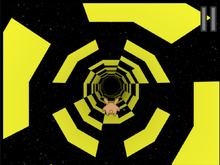
Normal tiles in The Crystal Gallery, part 10
Main article: Normal tile
Normal tiles are the most basic tile in the game. They consist of many many colors, and they don't have any special properties; you just stand on them, run on them, and they won't crumble. They are seen in almost all levels of the game Run 3. The first few levels are even completely made out of these Normal tiles. These tiles are never uncommonly seen, as they are the main tile, without all kinds of properties.
Crumbling Tiles
Main article: Crumbling tile
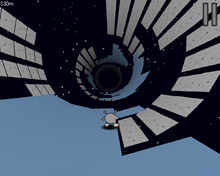
Crumbling tiles falling in Infinite mode.
Crumbling tiles are grey, stone-looking floor tiles that fall when you stand on them. The only exception is when playing as the Child; the Child can run across the Crumbling tiles without making them fall due to his light weight. However, if the Child jumps off of a Crumbling tile, it will fall.
Crumbling tiles can either be single tiles or, more commonly, in groups of multiple tiles together. Adjacent groups of tiles will be considered one big group, as long as they are touching by at least one corner. If a character runs or jumps on any tile in a group, it will set off a chain reaction, causing the whole cluster of tiles to fall in a descending pattern. The first tile touched will fall first, whereas the tiles furthest away from it will fall last by a space of a few moments. Some levels are covered in large groups of tiles, so it may be hard to complete a level if a group of tiles falls.
Ice Tiles and Ice Ramps
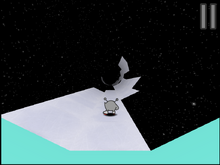
The Skater on a path of Ice tiles.
Main article: Ice tile
Ice tiles are always whitish-blue in color. The ice ramps work just the same as ramps, only that they are white. They are mainly seen in the Winter Games, and some of the side tunnels have them too. However, the tiles give every character a small speed boost and for non winter costumes, a decrease in maneuverability.
The Skier and Ice Skater will get a greater speed boost and an increase in maneuverability. This can help benefit you for letting you jump a greater distance, but you are needing to give up at least some maneuverability. That's why, people say that you need to give up something in order to get another things. Although these types of tiles are mostly seen in the Winter Games, they can still be seen in some other tunnels, for instance, the Box Storage Area.
Conveyor Tiles
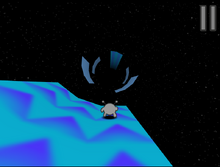
The Runner on a platform of forward-facing Conveyor tiles.
Main article: Conveyor tile
Conveyor tiles are tiles that only appear in The Way Onwards and Infinite Mode. These tiles can increase your momentum, or slow you down. They can also redirect you to left/right side, usually making it more difficult to navigate through the levels. But, they also prove to be useful, in such a case, like level 5 in the I-tunnel. But, they can be quite troublesome if you meet them in such a level. Since they can increase your speed, or slow you down, they can prove a challenge if you need to jump between platforms. Conveyor tiles are broken playing backwards (what looks forward is really backwards).
Notes
Conveyor tiles that point towards right/left hand side will only appear in the I-Tunnel, C-Tunnel, H-Tunnel, Infinite mode, and possibly more tunnels that branch off these tunnels. They will not appear in N-Tunnel, or any other tunnel currently featured in the game.
Strategy
Look for where the next platform is when you jump. If the direction the conveyor tiles point forward, jump earlier. If the conveyor tiles are pointing backwards (slowing down your speed), only jump until you are on the edge of your present platform, this will decrease the distance between platforms. If you are using a faster character (such as Skater, Bunny, though Bunny is not allowed in the N, H, and C (just Student) and I-tunnels), you need to make the jump to the next platform much earlier if the Conveyor tiles are pointing forward. You may jump a little later than usual if the conveyor tiles are pointing backwards. If there are many Conveyor tiles pointing left/right, they will divert your direction, making you turn to the other side, (thus making you fall right into a hole if you are unlucky and careless). You may want to keep jumping, making you less affected by their diverting behavior, but be more careful if you are using a fast-paced or inagile character, such as the Skater or the Child, as they are more difficult to maneuver when you jump.
Ramps
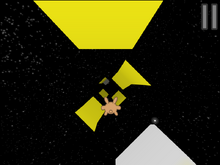
The Bunny, faced with the option of two equally good Ramps.
Main article: Ramp
Ramps are tiles that are tilted upwards in the front. If you skate on it or run on it, it will make you jump upwards. If your momentum is fast enough, you will be able to jump far, far away (if you are using the Skater, Angel). If you are slow, you will jump less quicker, like Runner, Student and Lizard. It is unknown if the Bunny will jump faster if it steps on a ramp. They are uncommon throughout the whole game, and unlike the Ice tiles and Power tiles, they are spread across all tunnels, and there isn't a tunnel with Ramps in every level.
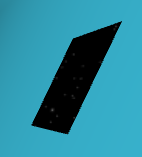
A hole in the midst of Normal tiles.
Holes
Main article: Hole
Do holes count as a tile? We personally think so. They just act as a "step on it and game over" tile in Run 1, but in Run 3, they are only tiles that let you float out into space. We're pretty sure that these tiles make quite a number of appearances in the whole game, and they serve a huge role in the series.
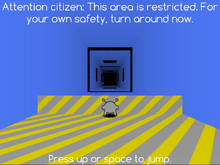
Barriers in Level 1, with the accompanying message.
Barriers
Main article: Barrier
Barriers are tiles that act as roadblocks or obstacles. They appear only in Level 1 and Launch Site C, making them the rarest type of tile in the game (not including Bouncy tiles, as they technically have not yet been implemented into the game.) They have look different in each of these appearances: yellow-and-light-grey striped in Level 1, as shown here, but they appear the same color as the Normal tiles of the level in Launch Site C. Research has shown that any kind of tile can serve as a barrier, as the barrier type is defined via separate tags from the tile type.
Boxes
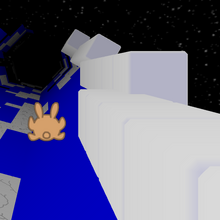
Bunny, next to a series of Boxes. (Captured in BSA, part 3)
Main article: Box
Boxes are obstacles which are placed in some levels in Run 2 and Run 3. They appear as large, white cubes. Boxes provide extra control over gravity in levels. The gravity in the tunnel will flip when a character jumps onto a perpendicular side of a Box like it would when a character runs onto a wall. Sometimes you can stand in front of a Box and stay there for a while for your speed to be slow. They can be rotated to take the shape of either a square or a diamond, can be opened (as shown in cutscenes) and can be pushed around with rings (as shown in Bridge Building and cutscenes). They won't float away if they are outside of the tunnel, as shown in the cutscene "Crossing the Gap" . They also appear in different tunnels other than the normal levels during the Bridge Building, for example, the last two levels of the A-Tunnel contain boxes.
Bouncy Tiles
Main article: Bouncy tile
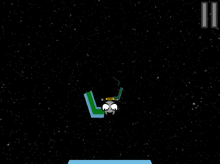
The Angel in a custom level with Bouncy tiles.
Bouncy tiles are tiles that are encountered in the level editor mode. You can't see them in Explore Mode or (yet). They are gravity-sensitive, and like Crumbling tiles, when you jump or land or walk or skate on them, they will bounce you up, making you jump higher than usual. If you are using the Child, since he is lightweight enough, they won't bounce you off immediately, they will only react when he jumps. If these Bouncy tiles are on a wall, you can't run or jump on them. You will immediately be bounced off instead. In this case, you will need to find a better location to walk on walls. Though they can be useful somehow, as they can make you jump further. They are always green.
Battery Tiles
Battery tiles are not actually tiles, but a special type of hole. They are placed in levels to alter where power cells can spawn, usually to aid gameplay of the Gentleman, and otherwise have no effect other than strange interactions with boxes. They do appear in certain levels in the game, but are exceptionally rare, only appearing in Level 2 (to aid with Hat Trick), Coordination Challenge parts 8 and 11, certain unreleased levels (specifically here and here), and Infinite Mode id-321. If loaded in the editor, they appear with a small battery icon; hence their name.
Movable Tiles
Tiles with orange rings on them are termed "movable." These rings can appear on normal tiles (most notably in Plan C, part 8, Memory Evaluation, part 3 and Coordination Challenge 5), and on boxes (most notably in Bridge Building).
Scrapped or Unused Tiles
- Nonrotating tiles are a scrapped type of tile on which the player retains the rotation they jumped to them from. The player cannot land on them at all if the tile is between 90-180 degrees above the player's rotation. Run 3 cannot load these tiles properly without modification. Once loaded, they appear as a slightly darker version of the color you set them to. They were once used in the ancient, since-scrapped Infinite Mode ID-10.
- Ruined tiles are scrapped tiles that function as a sort of combination of Nonrotating tiles and Crumbling tiles --- they don't allow the player to rotate the tunnel, and they crumble as crumbling tiles do when stepped on. They require modification to load properly. When loaded, they appear as a color inverted version of crumbling tiles (think light grey cracks on a black background). They have never been used in a level in-game.
- Inverse tiles were scrapped tiles that flipped rotation 180 degrees when stepped on, causing the player to fall upside down. Their collision information was removed from the game entirely, meaning they require extensive modification to properly re-enable. If re-enabled and loaded, they appear as a darker pink color modification to whatever color you set the level to. They were once used in the ancient and since-scrapped Infinite Mode IDs 10 and 11.
- Sticky tiles are scrapped tiles that function very similarly to slow conveyors, with an added effect of slowing down strafe speed and lessening jump height (hence their name). They require slight modification to enable. Once enabled, they appear an olive green color, tinted slightly to the color of the level. They have never been used in any level in the game.
- Bridge tiles are unused tiles that only affect the light bridge generated by the Pastafarian and the Pirate. They are used specifically to prevent the bridge from spawning on specific tiles, but otherwise function identically to holes. No level has ever used them in the game, but they can be loaded in the most recent version without needing to modify anything.
Capitalization of the tiles
For editors of this wiki, the tiles' names' capitalization are always an issue between editors. Some of them may think that this stuff is not that formal, and decide to not follow any rules for the tiles' names' capitalization. This may seem not a big issue, but it might make the readers uncomfortable if some decide to write in all capitalized, and some without any capitalization. Thus, we have decided to format the capitalization rules.
First of all, the tile names with the combination "Feature"+"Tile", such as Normal tiles, Crumbling tiles, should have the first word capitalized and second word with small characters. Example: Conveyor tiles
Secondly, the tiles name that only have one word. Then, the word itself should be capitalized. Example: Boxes
Thirdly, there are tiles with two features, like Ice ramps, capitalize the first word. Example: Ice ramps
Notes
Here are all the rules for capitalization. We know that there are already a ton of pages with the tile names not according to this page, but still, we want you editors to do us a favor and try to edit them if you see tiles with capitalization mistakes. Thanks!
| Run 3 ‹ Gameplay Mechanics • Achievements • Characters • Content • Easter Eggs • Story • Tiles • Tunnel • Levels • Planet • Wormhole • Walkthrough Guide • Angel Missions • Bridge Building • Backwards Mode › |

